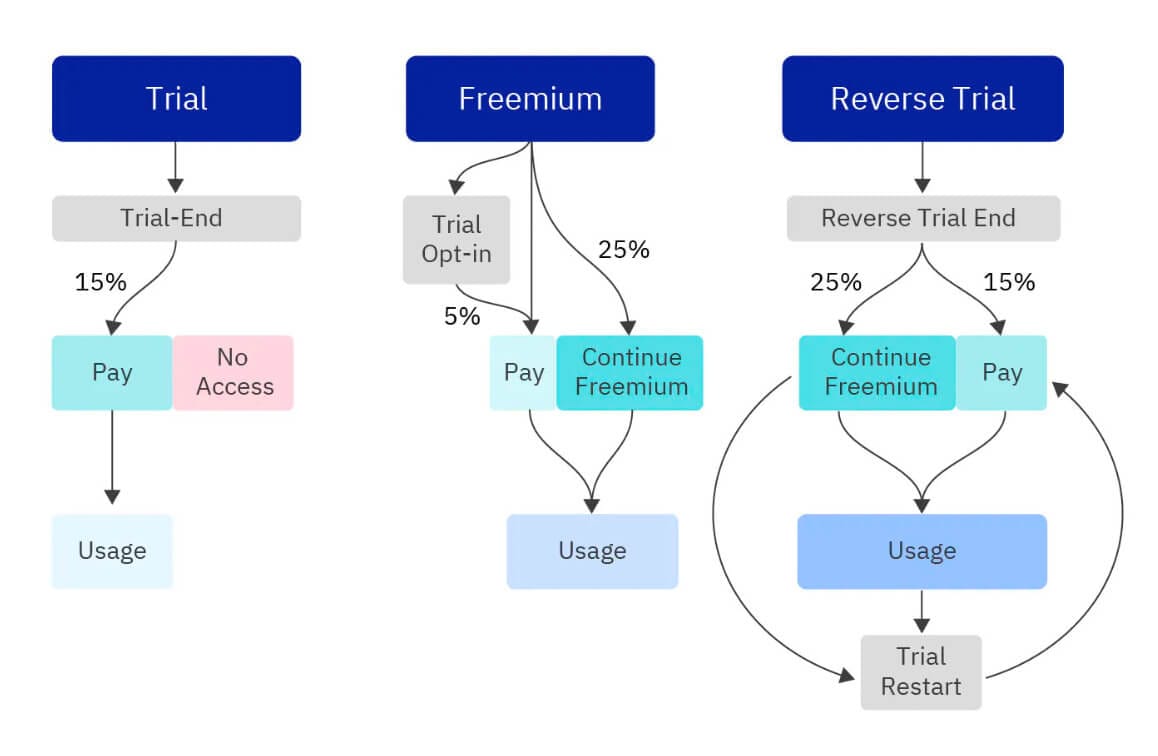- Growth with Gary
- Posts
- Reverse Trial: More SaaS Customers to retain and upgrade
Reverse Trial: More SaaS Customers to retain and upgrade
Reverse trial outperforms traditional free trials and freemium models for product-led growth SaaS. Keep users engaged longer, nurture upgrades, and meet customers where they are, on their timeline.
What is a reverse trial?
A reverse trial flips the normal SaaS free trial on its head. Instead of customers getting a taste of premium, and then having to pay or lose access, users always start on your full, premium version. When the 7-day or 30-day trial ends, instead of kicking them out, they drop down to a freemium plan with limitations, but they don’t lose access to the product entirely.
The goal: Maximize value from day one, get them sticky, and use the full breadth of features. Then make it super easy to upgrade when they're hooked.
Why Free Trial vs. Freemium vs. Reverse Trial?
Free Trial: Users get premium access for a limited time. When it ends, around 15% pay with the rest cut off, forced to leave, or downgrade.
Freemium: No trial, just a free plan. Users can pay to upgrade any time—but fewer (about 5%) do. 25% stick around for free.
Reverse Trial: Everyone starts premium. When the trial ends, about 15% pay. The rest slide into freemium, not kicked out, but still using with limitations and seeing value. Another 25% might stay in the ecosystem. They can choose to upgrade later, or even restart the trial. This model keeps more users engaged, holding onto them, and giving you more shots at conversion.
Why Reverse Trial Works (and Its Benefits)?
Reverse trials work because they reduce FOMO and friction. Users don't feel pressured. They aren't kicked off or forced to pay. Instead, they transition into a free plan, where they still see the value. They experience value quickly due to premium access and full paid features. Even when they're moved to the freemium limitation, they continue to receive value.
The activation key is to remind users, "Hey, this is a 7-day trial or a 30-day trial of premium access. Use these features now and discover them immediately." This approach increases long-term engagement because users have tried advanced features and are aware of the expiration date. When they are downgraded to the freemium plan with limitations, you can still keep them engaged with the product. Later, when they reflect, they might think, "Maybe I actually need some of those advanced features," creating a natural conversion opportunity. Users can upgrade later to regain access to premium advanced features.
This strategy is great for product-led growth because everything happens on the user's timeline, as long as you provide enough value from the beginning. This ensures users can adopt, get activated, and become acclimated to advanced features.
Think of it like this: you're keeping all these users who were about to leave. You're basically just giving people second chances and keeping them on a free MEM tier, which you already have. When the time comes, they'll come back and trigger. You just continue to engage with them.
Basically, they don't churn; they just have continuous use.
Read more about activation and product led growth bumper:
How to Build Reverse Trials for Your SaaS
1. Let Everyone Start Premium
All new signups get access to your full product for 7, 14, or 30 days. Highlight the best features during this time. Make sure customers are discovering the advanced features. Use the 30-minute onboarding calls as UX research and see if users can spot advanced features.
2. Plan the Downgrade and Build “Upgrade” Moments
When the trial ends, don't kick them out, alert them they are moving into the freemium tier. Make sure the downgrade experience is clear, and they are losing access to advanced features. Give them a heads up 3-to-5 days before the trial end.
I believe this is the job of the customer success team, read more here:
3. Allow Trial Restarts but Qualify Prospects
If a long-time freemium user wants another shot at premium, let them restart the trial with stipulations. Consider using your product-led sales team to determine and qualify prospects before moving forward.
4. Track and Iterate
Watch conversion rates from both trial-to-paid and freemium-to-paid. Adjust timelines, feature gates, and messaging based on what keeps people coming back.
How does Reverse Trial fit in SaaS?
Reverse trials are a friendly handshake, not a sales trap. They invite users to experience your best, stick around, and pay when it makes sense. For B2B PLG SaaS, it’s a natural fit, you meet prospects where they are, on their timeline, lower the stakes, allow them to stick around, and nurture them to restart when timing is right.
P.S. If you have 2 min, please take this three-questions survey about this newsletter for me @ https://tally.so/r/3EaPyl
New here? Here’s what to expect each week:
- Monday: spotlight a lesser-known PLG company
- Tuesday: my PLG experience
- Wednesday: Memes on product, AI, and marketing
- Thursday: tactical growth tips
- Friday: raw accounts of my startup journey
I write daily*** about my learning on launching and leading PLG. Feel free to subscribe.

I am Gary Yau Chan. 3x Head of Growth. Product Growth specialist. 26x hackathon winner. Building ClarityInbox. I write about #PLG and #BuildInPublic. Please follow me on LinkedIn, or read about what you can hire me for on my Notion page.




